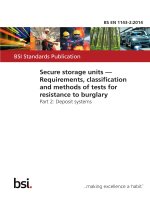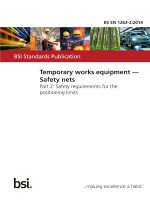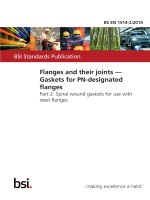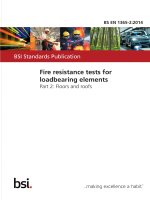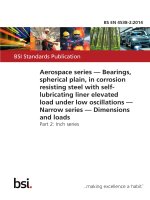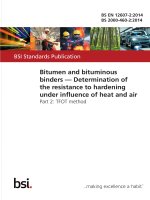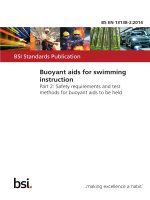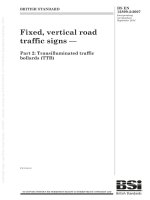Bsi bs en 62343 2 2014
Bạn đang xem bản rút gọn của tài liệu. Xem và tải ngay bản đầy đủ của tài liệu tại đây (1.32 MB, 26 trang )
BS EN 62343-2:2014
BSI Standards Publication
Dynamic modules
Part 2: Reliability qualification
BRITISH STANDARD
BS EN 62343-2:2014
National foreword
This British Standard is the UK implementation of EN 62343-2:2014. It is
identical to IEC 62343-2:2014. It supersedes BS EN 62343-2:2011 which
is withdrawn.
The UK participation in its preparation was entrusted by Technical
Committee GEL/86, Fibre optics, to Subcommittee GEL/86/3, Fibre optic
systems and active devices.
A list of organizations represented on this committee can be obtained on
request to its secretary.
This publication does not purport to include all the necessary provisions of
a contract. Users are responsible for its correct application.
© The British Standards Institution 2014.
Published by BSI Standards Limited 2014
ISBN 978 0 580 82510 1
ICS 33.180.10
Compliance with a British Standard cannot confer immunity from
legal obligations.
This British Standard was published under the authority of the
Standards Policy and Strategy Committee on 31 October 2014.
Amendments/corrigenda issued since publication
Date
Text affected
EUROPEAN STANDARD
EN 62343-2
NORME EUROPÉENNE
EUROPÄISCHE NORM
September 2014
ICS 33.180
Supersedes EN 62343-2:2011
English Version
Dynamic modules - Part 2: Reliability qualification
(IEC 62343-2:2014)
Modules dynamiques - Partie 2: Qualification de fiabilité
(CEI 62343-2:2014)
Dynamische Module - Teil 2: Beurteilung der
Zuverlässigkeit
(IEC 62343-2:2014)
This European Standard was approved by CENELEC on 2014-09-01. CENELEC members are bound to comply with the CEN/CENELEC
Internal Regulations which stipulate the conditions for giving this European Standard the status of a national standard without any alteration.
Up-to-date lists and bibliographical references concerning such national standards may be obtained on application to the CEN-CENELEC
Management Centre or to any CENELEC member.
This European Standard exists in three official versions (English, French, German). A version in any other language made by translation
under the responsibility of a CENELEC member into its own language and notified to the CEN-CENELEC Management Centre has the
same status as the official versions.
CENELEC members are the national electrotechnical committees of Austria, Belgium, Bulgaria, Croatia, Cyprus, the Czech Republic,
Denmark, Estonia, Finland, Former Yugoslav Republic of Macedonia, France, Germany, Greece, Hungary, Iceland, Ireland, Italy, Latvia,
Lithuania, Luxembourg, Malta, the Netherlands, Norway, Poland, Portugal, Romania, Slovakia, Slovenia, Spain, Sweden, Switzerland,
Turkey and the United Kingdom.
European Committee for Electrotechnical Standardization
Comité Européen de Normalisation Electrotechnique
Europäisches Komitee für Elektrotechnische Normung
CEN-CENELEC Management Centre: Avenue Marnix 17, B-1000 Brussels
© 2014 CENELEC All rights of exploitation in any form and by any means reserved worldwide for CENELEC Members.
Ref. No. EN 62343-2:2014 E
BS EN 62343-2:2014
EN 62343-2:2014
-2-
Foreword
The text of document 86C/1185/CDV, future edition 2 of IEC 62343-2, prepared by SC 86C "Fibre
optic systems and active devices” of IEC/TC 86 “Fibre optics" was submitted to the IEC-CENELEC
parallel vote and approved by CENELEC as EN 62343-2:2014.
The following dates are fixed:
•
latest date by which the document has to be
implemented at national level by
publication of an identical national
standard or by endorsement
(dop)
2015-06-01
•
latest date by which the national
standards conflicting with the
document have to be withdrawn
(dow)
2017-09-01
This document supersedes EN 62343-2:2011.
Attention is drawn to the possibility that some of the elements of this document may be the subject of
patent rights. CENELEC [and/or CEN] shall not be held responsible for identifying any or all such
patent rights.
Endorsement notice
The text of the International Standard IEC 62343-2:2014 was approved by CENELEC as a European
Standard without any modification.
In the official version, for Bibliography, the following notes have to be added for the standards indicated:
IEC 61000-4-2
NOTE
Harmonized as EN 61000-4-2.
IEC 61000-4-3
NOTE
Harmonized as EN 61000-4-3.
IEC 61000-4-4
NOTE
Harmonized as EN 61000-4-4.
IEC 61000-4-5
NOTE
Harmonized as EN 61000-4-5.
IEC 61000-4-6
NOTE
Harmonized as EN 61000-4-6.
IEC 61291-5-2
NOTE
Harmonized as EN 61291-5-2.
IEC 61300-2-5
NOTE
Harmonized as EN 61300-2-5.
IEC 61300-2-9
NOTE
Harmonized as EN 61300-2-9.
IEC 61300-2-42
NOTE
Harmonized as EN 61300-2-42.
IEC 61300-2-44
NOTE
Harmonized as EN 61300-2-44.
IEC 61753-1
NOTE
Harmonized as EN 61753-1.
CISPR 22
NOTE
Harmonized as EN 55022.
-3-
BS EN 62343-2:2014
EN 62343-2:2014
Annex ZA
(normative)
Normative references to international publications
with their corresponding European publications
The following documents, in whole or in part, are normatively referenced in this document and are
indispensable for its application. For dated references, only the edition cited applies. For undated
references, the latest edition of the referenced document (including any amendments) applies.
NOTE 1 When an International Publication has been modified by common modifications, indicated by (mod), the relevant
EN/HD applies.
NOTE 2 Up-to-date information on the latest versions of the European Standards listed in this annex is available here:
www.cenelec.eu
Publication
IEC 61300-2-1
Year
-
IEC 61300-2-4
-
IEC 61300-2-12
-
IEC 62005-9-1
-
IEC 62005-9-2
-
IEC 62572 series
ISO 9000
1)
At draft stage.
-
Title
EN/HD
Fibre optic interconnecting devices and
EN 61300-2-1
passive components - Basic test and
measurement procedures -- Part 2-1: Tests
- Vibration (sinusoidal)
Fibre optic interconnecting devices and
EN 61300-2-4
passive components - Basic test and
measurement procedures -- Part 2-4: Tests
- Fibre/cable retention
Fibre optic interconnecting devices and
EN 61300-2-12
passive components - Basic test and
measurement procedures -- Part 2-12:
Tests - Impact
1)
Fibre optic interconnecting devices and
EN 62005-9-1
passive components - Reliability -- Part 91: Qualification of passive optical
components
Reliability of fibre optic interconnecting
devices and passive optical components -Part 9-2: Reliability qualification for single
fibre optic connector sets - single mode
Fibre optic active components and devices EN 62572 series
- Reliability standards
Quality management systems Fundamentals and vocabulary
Year
-
-
-
-
-
-
–2–
BS EN 62343-2:2014
IEC 62343-2:2014 © IEC 2014
CONTENTS
1
Scope .............................................................................................................................. 5
2
Normative references ...................................................................................................... 5
3
Terms, definitions and abbreviations ............................................................................... 6
3.1
Terms and definitions .............................................................................................. 6
3.2
Abbreviated terms ................................................................................................... 6
4
Reliability qualification considerations ............................................................................. 7
4.1
General ................................................................................................................... 7
4.2
General consideration approach ............................................................................. 7
4.3
DM product design .................................................................................................. 7
5
Reliability qualification requirements................................................................................ 7
5.1
General ................................................................................................................... 7
5.2
Demonstration of product quality ............................................................................. 8
5.3
Testing responsibilities ........................................................................................... 8
5.4
Tests ...................................................................................................................... 9
5.4.1
Thorough characterization ............................................................................... 9
5.4.2
Reliability qualification of components, parts and interconnections .................. 9
5.4.3
Reliability qualification of DM assembly process .............................................. 9
5.4.4
Reliability qualification of the Design 1 DM ...................................................... 9
5.4.5
Reliability qualification of the Design 2 DM .................................................... 11
5.4.6
Pass/fail criteria ............................................................................................. 13
Reliability assessment procedure .......................................................................... 13
5.5
5.5.1
Analysis of reliability results .......................................................................... 13
5.5.2
Reliability calculations ................................................................................... 13
5.5.3
Reliability qualification test methods .............................................................. 14
Guidance – FMEA and qualification-by-similarity ........................................................... 14
6
Annex A (informative)
Reliability test items and their conditions .......................................... 16
A.1
General ................................................................................................................. 16
A.2
Mechanical environment tests ............................................................................... 16
A.3
Temperature and humidity environmental tests ..................................................... 17
A.4
Electromagnetic compatibility tests ....................................................................... 17
A.5
Fibre integrity tests ............................................................................................... 18
Bibliography .......................................................................................................................... 20
Table 1 – Minimum list for tests required on Design 1 DMs ................................................... 10
Table 2 – Minimum list for tests required on Design 2 DMs ................................................... 12
Table 3 – Failure rate of parts ............................................................................................... 14
Table 4 – Relevant list of IEC reliability test methods for optical components ........................ 14
Table A.1 – Mechanical environmental tests and severity ..................................................... 16
Table A.2 – Temperature and humidity tests and severity ..................................................... 17
Table A.3 – Electromagnetic compatibility test items and their severities .............................. 18
Table A.4 – Fibre integrity test items and their severities ...................................................... 19
BS EN 62343-2:2014
IEC 62343-2:2014 © IEC 2014
–5–
DYNAMIC MODULES –
Part 2: Reliability qualification
1
Scope
This part of IEC 62343 applies to dynamic modules and devices (DMs) which are
commercially available. Examples are tuneable chromatic dispersion compensators,
wavelength selective switches and optical channel monitors.
Optical amplifiers are not included in this list, but are treated in IEC 61291-5-2.
For reliability qualification purposes, some information about the internal components, parts
and interconnections is needed; these internal parts are treated as black boxes. This standard
gives requirements for the evaluation of DM reliability by combining the reliability of such
internal black boxes.
The objectives of this standard are the following:
•
to specify the requirements for the reliability qualification of DMs;
•
to give the minimum list of reliability qualification tests, requirements on failure criteria
during testing and on reliability predictions, and give the relevant normative references.
2
Normative references
The following documents, in whole or in part, are normatively referenced in this document and
are indispensable for its application. For dated references, only the edition cited applies. For
undated references, the latest edition of the referenced document (including any
amendments) applies.
IEC 61300-2-1, Fibre optic interconnecting devices and passive components – Basic test and
measurement procedures – Part 2-1: Tests – Vibration (sinusoidal)
IEC 61300-2-4, Fibre optic interconnecting devices and passive components – Basic test and
measurement procedures – Part 2-4: Tests – Fibre/cable retention
IEC 61300-2-12, Fibre optic interconnecting devices and passive components – Basic test
and measurement procedures – Part 2-12: Tests – Impact
IEC 62005-9-1, Fibre optic interconnecting devices and passive components – Reliability –
Part 9-1: Qualification of passive optical components 1
IEC 62005-9-2, Reliability of fibre optic interconnecting devices and passive optical
components – Part 9-2: Reliability qualification for single fibre optic connector sets – Single
mode
IEC 62572 (all parts), Fibre optic active components and devices – Reliability standards
ISO 9000: Quality management systems – Fundamentals and vocabulary
___________
1
To be published.
BS EN 62343-2:2014
IEC 62343-2:2014 © IEC 2014
–6–
3
Terms, definitions and abbreviations
3.1
Terms and definitions
For the purposes of this document, the following terms and definitions apply.
3.1.1
failure
non-compliance to product specification or change in parameters as set by the standard or
agreed by the customer and supplier
3.1.2
qualification
commonly used as the abbreviation for reliability qualification
Note 1 to entry: It is used as a formal testing to determine whether or not the product is suitable for telecom
applications and, therefore, “pass or fail” is the expected outcome
Note 2 to entry: This is different from a reliability test, which is in nature a reliability “engineering test”. Reliability
tests are designed to understand the reliability consideration or estimate the reliability of the product. Pass or fail is
not the main output.
3.1.3
reliability
< time period > minimum period of DM continuous operation without failure at specified
operating and environmental conditions
3.1.4
environmental conditions
to
perform
required
functions
at
specified
operating
and
Note 1 to entry: The reliability of a DM is expressed by either of the following two parameters: mean time between
failure (MTBF) and failures in time (FIT):
•
the MTBF is the mean period of DM continuous operation without any failure at specified operating and
environmental conditions;
•
the FIT is the number of failures expected in 10 9 device-hours at specified operating and environmental
conditions.
3.2
Abbreviated terms
DM
dynamic module
DS
detail specification
ESD
electrostatic discharge
FIT
failure in time
FMEA
failure mode and effects analysis
LCD
liquid crystal device
MTBF
mean time between failure
RH
relative humidity
UCL
upper confidence level
VOA
variable optical attenuators
BS EN 62343-2:2014
IEC 62343-2:2014 © IEC 2014
4
4.1
–7–
Reliability qualification considerations
General
Since DMs are relatively new products in the commercial market and involve different
technologies, the requirements included in this standard will need to be reviewed as
technology progresses.
4.2
General consideration approach
It is worth emphasizing the fundamental approach of reliability qualification adopted in this
standard:
a)
Any parts that can be effectively qualified on their individual levels shall be qualified at
that level. Their qualification shall be based on IEC standards or other industrial
standards in the absence of such IEC standards.
b)
The qualification tests required at DM level shall be based on the degradation
mechanisms and failure modes that cannot be effectively detected in the lower part levels.
At the DM level, the qualification tests shall not attempt to discover or identify those
degradation mechanisms and failure modes that can be discovered in the lower assembly
levels than the final product level. For example, if all parts in the DM can be effectively
tested for damp heat-accelerated degradations, there is no need to repeat the damp heat
test at the DM level.
4.3
DM product design
A DM is an assembly of various components, parts and interconnections. There are two basic
designs in the current commercial DM market:
a)
Design 1: parts (as a general term that includes components, parts and interconnections
used to build a DM from the of point of view of this standard) are packaged separately.
Their packages are usually either hermetic or moisture-resistant. They are integrated into
a housing (usually non-hermetic or not moisture-resistant).
b)
Design 2: some parts used in DMs are unpackaged basic optical elements (e.g. crystals,
lenses, mirrors, etc.). These parts cannot be effectively qualified by themselves. These
parts/elements are integrated and packaged inside a hermetic box or moisture-resistant
box.
In Design 1, the individual parts can be tested and qualified individually and therefore, the DM
qualification does not have to repeat the tests that are performed in the part levels for the
same degradation mechanisms and failure modes.
In Design 2, the DM qualification is again focused on the tests that cannot be effectively
performed in the lower assembly levels (i.e., the basic part level). However, in this case there
are usually more tests required since the parts cannot be effectively tested at the part level
individually.
Due to the differences in the designs, and therefore different mechanisms and failure modes,
different qualification test approaches have to be developed separately. They are described in
5.4.4 for Design 1 and 5.4.5 for Design 2, respectively.
5
5.1
Reliability qualification requirements
General
For the purpose of this standard, each internal component, part and interconnection shall be
treated as a black box. It is also important to point out that the parts in the DM of this design
include the fibre splicing, fibre routing and fibre anchoring, as well as how the fibre exits from
the housing and how parts are mounted.
–8–
BS EN 62343-2:2014
IEC 62343-2:2014 © IEC 2014
This standard is based on the assumption that the reliability of a DM can be evaluated with
sufficient confidence from the FIT rates of its internal black boxes when the assembly process
of the constituents has been qualified.
There are degradation and failures not due to part failures. An example is the fibre routing
and fibre holders. The quality and reliability of the assembling, for example fibre routing, shall
be assessed and qualified through the process evaluation and qualification. The procedures
to qualify the assembly process are described in 5.4.3.
The internal black boxes often constituting a DM are listed below:
•
passive optical components, including patch cords, pigtails, connectors and splices;
•
active optical components;
•
electronics, including PCBs, electrical connectors, etc.
•
others (e.g. fibre splicing, fibre routing and fibre anchoring, as well as how the fibre exits
from the housing and how components are mounted).
The DM manufacturers shall declare the number and type of the internal black boxes
constituting the DM and give the failure rates (in FITs) for each black box.
The DM failure rate shall be calculated by suitably combining the failure rates in FITs of its
black boxes, as described in the 5.5.2. The model and assumptions used in DM failure rate
calculation shall be provided and justified for review, if the DM manufacturer has so requested.
5.2
Demonstration of product quality
Since the reliability qualification tests are performed on a limited number of units, it is
essential to have a quality management system in place to assure that the quality of all units
is consistent. Testing on a limited number of samples will be representative of the production
units to be delivered after the qualification is completed.
This standard (where required by the detailed specification) specifies the minimum mandatory
requirements to assess reliability qualification of a DM and is intended to be part of a total DM
reliability program and quality management system developed and implemented by the DM
manufacturer.
The DM manufacturer shall demonstrate:
•
a documented and audited manufacturing process, including the reliability qualification of
purchased parts, in accordance with ISO 9000;
•
performance data of production units shall be available for review, and its distribution shall
show processes are under adequate controls;
•
a reliability qualification programme, including, for example, accelerated life testing, burnin and screening of parts and DMs;
•
a reliability qualification maintenance programme to ensure continuity of qualification
status (this can be achieved by means of periodic reliability qualification tests of the
product or similar products);
•
a procedure to ensure an appropriate feedback to development and production on
reliability issues.
5.3
Testing responsibilities
The DM manufacturer is responsible for performing reliability qualification testing.
The testing detailed in this standard shall be performed by the DM manufacturer. Additional
testing may be specified in the detailed specification.
BS EN 62343-2:2014
IEC 62343-2:2014 © IEC 2014
5.4
5.4.1
–9–
Tests
Thorough characterization
A thorough characterization of the product for its performance (may be beyond those in the
performance specifications) and overall operating conditions (may be beyond those in the
operating condition specifications) shall be performed. The data shall be collected and
analysed (minimal for the mean and standard deviation), and be available for review.
5.4.2
Reliability qualification of components, parts and interconnections
All components, parts, and interconnections used to build DMs shall be qualified according to
the appropriate IEC standards for each of them. The components may include, but are not
limited to, variable optical attenuators (VOAs), taps/splitters, detectors, isolators, circulators,
electronic components, splicing connections (including the packaging or re-coating), crystals,
mirrors, prisms, etc.
If the IEC standards for the parts are under development or not yet available, the IEC
standards for parts of similar failure modes and degradation mechanisms should be adopted.
An analysis of similarity of failure modes and degradation mechanisms shall be provided to
support the approach.
Considerations shall be given to designs that use many pieces of same parts. The failure
rates of such parts may significantly contribute to the overall system failure rate or downtime.
The cumulative degradation from individual parts should also be investigated. The results may
require tests on additional samples or more stringent failure definitions.
Additionally, the pass/fail criteria of the part qualification shall be thoroughly examined to
determine whether or not the part qualification is adequate. For an example, if several 1x2
taps are used in a series design, not only the failure rate but also the degradation is multiplied
(i.e. 0,5 dB pass/fail criterion is multiplied), which may not be acceptable. The pass/fail
criterion of the parts commonly defined as 0,5 dB changes in insertion loss is much too loose
for the needs of a product such as a DM. The assessment of tighter criteria shall be carried
out and the qualification status justified.
5.4.3
Reliability qualification of DM assembly process
Fibre routing and component mounting are both important module assembling processes, and
they can be significant failure rate contributors if they are not done properly. Their designs
and processes shall be thoroughly documented and tested. Any changes shall be supported
by adequate experiment data.
If the fibre routing is thoroughly documented and controlled (e.g. through performance
measurements before and after routing) and the final DM is qualified, the fibre routing process
can be considered as a qualified process and can be used in other similar products to
produce a product that is claimed to be qualified by similarity.
5.4.4
Reliability qualification of the Design 1 DM
As described in 5.1 for Design 1, parts (components used to build a DM) are packaged
separately. Their packages are usually either hermetic or moisture-resistant. They are
integrated into a housing (usually non-hermetic or not moisture-resistant).
A reliability qualification procedure related to the complete DMs is described in Table 1. It
gives the minimum list of tests to be performed on DMs in order to assure reliability.
For the tests, no failures are allowed. The tests can be performed sequentially or in parallel.
For “operational” tests, relevant parameters should be monitored during the test.
BS EN 62343-2:2014
IEC 62343-2:2014 © IEC 2014
– 10 –
On the basis of the reliability assurance required for the reliability tests for the DM internal
black boxes, the sampling level is generally low (for example a few samples for each DM
type).
In some specific cases the use of adhesives in the DM can be considered as a critical process
and shall require separate qualification. Depending on the possible function of the adhesive
(mechanical anchoring, splice protection, index matching, etc.), the different failure modes
shall be addressed and supported by reliability/qualification data.
The main point in the reliability qualification of the Design 1 DMs is to ensure that the
reliability of each part is not degraded in the manufacturing process used.
Table 1 – Minimum list for tests required on Design 1 DMs
Test
Condition
Duration
Samples
85 °C
2 000 h
3
T op, min /T op, max
>1 °C/min
100 cycles
3
100 mm height drop for
<10 kg, 75 mm drop for 10
kg − 25 kg
See table below
3
10 Hz to 55Hz, 1,52 mm,
1 octave/min
2 h per direction
3
See table below
3
3 times/direction
3
2 sweeps/direction
3
Active high temperature aging
Operational temperature cycling
Drop (impact)
Non-operational
mechanical test
Vibration
b
a
Pull
5/10/100 N
c
2,
400 m/s 5ms for
+/- z-axis,
Operational shock
200 m/s 2 , 5ms for
+/- x-axis,
d
100 m/s 2 , 5 ms for
+/- y-axis
50 Hz to 500 Hz,
Operational vibration
d
20 m/s 2 for z-axis,
10 m/s 2 for x-axis,
5 m/s 2 for y-axis
NOTE
a
A reference to the temperature cycle test method is provided in Clause A.3.
Mechanical test: Impact (drop) (IEC 61300-2-12 for drop)
Mass
kg
Drop height
mm
0 to < 10
100
10 to < 25
75
b
Mechanical test: vibration(sinusoidal, IEC 61300-2-1).
c
Pigtail testing (pull test). The first figure in each row is the outer diameter of the buffered or cabled fibre to
which the specified test conditions apply.
Cable
retention
(pull)
d
2 mm: 20 N to100 N, 3 times, 5 s pulls
900 µm 10 N, 3 times, 5 s pulls
IEC 61300-2-4
250 µm: 5 N, 3 times, 5 s pulls
The directions of the x, y and z axes are defined by mounting direction to a board in a equipment (x-axis: the
direction which is according to the front and back of the board to be mounted when the board is installed in a
piece of equipment; y-axis: the direction which is according to the gravity (up and down) of the board to be
mounted when the board is installed in a piece of equipment; z-axis: the direction which is perpendicular to
the board to be mounted.) If a tester cannot define the mounting direction, the test shall be carried out in the
most severe conditions for all directions.
BS EN 62343-2:2014
IEC 62343-2:2014 © IEC 2014
– 11 –
It is essential that the evaluated DMs are entirely representative of standard production and
have passed all the production procedures and/or specified (where applicable in the DS) burnin and screening procedures.
Aspects of the test conditions not provided in the present standard are given in the relevant
detail specifications.
5.4.5
Reliability qualification of the Design 2 DM
A reliability qualification procedure related to design 2 DMs is described in Table 2. In this DM
design, Design 2, not all parts can be effectively tested by themselves (see 4.3). Therefore,
many of the long-term environmental tests can only be effectively tested and qualified in the
DM final product assembly level.
For the test, no failures are allowed. The tests can be performed sequentially or in parallel.
For “operational” tests, relevant parameters should be monitored during the test.
For example, some of the parts may have been qualified by the damp heat test but others
may not pass the damp heat test as required for telecommunications applications. Therefore,
the DM units with all the parts assembled shall be tested in damp heat conditions. This may
seem redundant, but it is necessary.
BS EN 62343-2:2014
IEC 62343-2:2014 © IEC 2014
– 12 –
Table 2 – Minimum list for tests required on Design 2 DMs
Test
Condition
Duration
Samples
85 °C
2 000 h
3
T op, min /T op, max
>1 °C/min
100 cycles
3
85 °C/85 % RH a
500 h
3
100 mm height drop for
<10 kg, and 75 mm drop
for 10 kg – 25 kg
See table below
3
10 Hz to 55 Hz,
1,52mm,1 octave/min
2 h per direction
3
5/10/100 N
See table below
3
3 times/direction
3
2 sweeps/direction
3
Active high temperature aging
Operational temperature cycling
Damp heat
Drop (impact)
Non-operational
mechanical test
Vibration
Pull
b
c
d
400
Operational shock
m/s 2 ,
5ms for
± z-axis,
200 m/s 2 , 5ms for
± x-axis,
e
100 m/s 2 , 5ms for
± y-axis
50 Hz to 500 Hz,
Operational vibration
20 m/s 2 for z-axis
e
10 m/s 2 for x-axis
5 m/s 2 for y-axis
Hermeticity (checked before and after
liquid-to-liquid thermal shock)
NOTE
∆T = 100 °C
15 cycles
3
dummy box
A reference to the temperature cycle test method is provided in Clause A.3.
a
Damp heat: the damp heat test at 85 °C/85 % RH for 100 h has been advocated by some manufacturers.
These test conditions may be used. Otherwise, the damp heat test at 40 °C/93 % RH for a much longer
duration may be used with the actual duration to be determined by the acceleration factor.
b
Mechanical test: impact (IEC 61300-2-12).
Mass
kg
Drop height
mm
0 to <10
100
10 to <25
75
c
Mechanical test: vibration (sinusoidal, IEC 61300-2-1).
d
Pigtail testing (pull test). The first figure in each row is the outer diameter of the buffered or cabled fibre to
which the specified test conditions do apply.
Cable
retention
(pull)
e
2 mm: 20 N to100 N, 3 times, 5 s pulls
900 µm: 10 N, 3 times, 5 s pulls
IEC 61300-2-4
250 µm: 5 N, 3 times, 5 s pulls
The direction of the x, y and z axes are defined by mounting direction to a board in a piece of equipment (xaxis: the direction which is according to the front and back of the board to be mounted when the board is
installed in a piece of equipment; y-axis: the direction which is according to the gravity (up and down) of the
board to be mounted when the board is installed in a piece of equipment; z-axis: the direction which is
perpendicular to the board to be mounted.) If a tester cannot define the mounting direction, the test shall be
done in the most severe conditions for all directions.
It is essential that the evaluated DMs are entirely representative of standard production and
have passed all the production procedures and/or specified (where applicable in the DS) burnin and screening procedures.
Aspects of the test conditions not provided in the present standard are given in the relevant
standards.
BS EN 62343-2:2014
IEC 62343-2:2014 © IEC 2014
5.4.6
– 13 –
Pass/fail criteria
It should be noted that the commonly used failure criterion of a drift of higher than 0,5 dB in
insertion loss (IL) is a guideline. For DWDM DMs, such as wavelength blockers, centre
wavelength drift shall be defined as a failure criterion. The actual and practical criteria should
be developed based on the degradation allowed for the expected life of the product. An
example is provided below to illustrate the determination.
EXAMPLE:
•
The acceleration factor of the testing condition to the operating condition is 50.
•
The beginning-of-life parametric measurement is 1,0 dB below the end-of-life specification.
•
Assume the expected life is 20 years.
•
Allowed degradation for a 2 000 h testing is: (1,0*50*2 000)/(20*365,25*24) = 0,57 dB.
•
Note that IL is not the only parameter considered for pass/fail; other parameters are included.
5.5
Reliability assessment procedure
5.5.1
Analysis of reliability results
The DM customer/SS shall have a procedure to analyse and verify reliability claims of a DM
manufacturer. In particular, the procedure should include the analysis of
•
life test data for the complete dynamic module,
•
life test data for internal parts,
•
environmental test results.
The analysis of results leads to reporting the reliability parameters of the DM for each type of
device or sub-system. Minimum reliability parameters shall be presented as in Table 4 (see
below).
5.5.2
Reliability calculations
A reliability prediction regarding the complete DM is provided by the DM manufacturer, based
on the failure rates (in FIT “failure in time”) of the internal black boxes composed of the DM
(Design 1) or based on the data for the complete DM (Design 2).
The failure rates of the internal black boxes shall be given by the DM manufacturer taking into
account the basic values issued from the cumulated component-hours issued from the
different parts included in DM. The calculations for each internal black box shall be based on
the current standards regarding reliability calculations.
The reliability calculations will also include the wear-out failures. The FIT figures given for
each internal black box shall take into account all expected failure modes.
The FIT figures of the internal black boxes shall be combined to give the failure rate of the
Design 1 DM as explained in Table 3.
BS EN 62343-2:2014
IEC 62343-2:2014 © IEC 2014
– 14 –
Table 3 – Failure rate of parts
Element
Number of
elements
Measured value (UCL 95 %)
Splice
n2
A2
FIT (random failure)
Connector
n3
A3
FIT (random failure)
Electronics
n4
A4
FIT (random failure)
Active component type 1
n (4+1)
A (4+1)
FIT (random and wear-out failure)
Active component type 2
n (4+2)
A (4+2)
FIT (random and wear-out failure)
…………………………………………
Active component type m
…………………………………………………
n (4+m)
A (4+m)
FIT (random and wear-out failure)
Other internal component type 1
n (4+m+1)
A (4+m+1) FIT (random failure)
Other internal component type 2
n (4+m+2)
A (4+m+2) FIT (random failure)
…………………………………………
Other internal component type h
……………………………….
n (4+m+h)
A (4+m+h)
FIT (random failure)
Passive optical component type 1
n (4+m+h+1)
A (4+m+h+1)
FIT (random failure)
Passive optical component type 2
n (4+m+h+2)
A (4+m+h+2)
FIT (random failure)
…………………………………………
……………………………….
n (4+m+h+k)
A (4+m+h+k)
FIT (wear-out failure)
Optical component attachment
n (4+m+h+k)
A (4+m+h+k)
FIT
Any other failure modes identified in
FMECA
n (4+m+h+k)
A (4+m+h+k)
FIT
Passive optical component type k
Fibre routing
∑ i A i *n I
Total failure rate
NOTE
5.5.3
n i is the number of components of each type included in the DM.
Reliability qualification test methods
Table 4 shows a list of normative references relevant reliability qualification tests and test
conditions for constituting components used for DMs.
Table 4 – Relevant list of IEC reliability test methods for optical components
Constituting components
IEC reference
(reliability qualification document number)
Passive optical components
IEC 62005-9-1
Optical connectors
IEC TR 62005-9-2
Active optical components
IEC series 62572
6
Guidance – FMEA and qualification-by-similarity
It is worth emphasizing that the reliability assessment or qualification tests shall be based on
the degradation mechanisms and failure modes. The appropriate accelerated tests can be
developed once the degradation mechanisms, failure modes, and their acceleration factors
are understood. To begin with, the failure mode and effects analysis (FMEA) should be
developed. A set of reliability tests should be planned and conducted as the result of FMEA.
The testing results can be used to develop additional tests or refined tests to better
understand the degradation mechanisms or develop the acceleration models.
BS EN 62343-2:2014
IEC 62343-2:2014 © IEC 2014
– 15 –
Where a range of dynamic modules is produced by a DM manufacturer, there may be some
significant similarity between different type codes. A combination of results from different test
programmes, where appropriate, is therefore permitted.
Consideration should be given to the fact that minor differences in technology or processing
can sometimes have a major impact on reliability, whilst not being apparent during quality
assessment.
As a minimum, FMEA shall be carried out for all varieties of products that are considered
“similar” and claimed to be “qualified” by “similarity”. FMEA shall be carried out thoroughly in
order to be an effective tool to consider “qualified-by-similarity”. Its thoroughness can be
checked against the failure mode analysis (FMA), based on manufacturing drop-out and
customer returns.
Evidence should be presented which demonstrates that all results are directly relevant.
BS EN 62343-2:2014
IEC 62343-2:2014 © IEC 2014
– 16 –
Annex A
(informative)
Reliability test items and their conditions
A.1
General
This annex provides information on reliability test items and conditions for DMs. The tester
can select reliability test items and conditions by referring to the following.
A.2
Mechanical environment tests
Table A.1 shows the severity of test items for the mechanical environmental tests. For a
dynamic module with moving parts, such as MEMS mirrors, it is strongly recommended to test
operating mechanical shock and vibration. Operating mechanical shock and vibration tests
are carried out by monitoring the performance of dynamic modules during the tests. The
transportation vibration and handling drop test should be carried out as packed modules.
Table A.1 – Mechanical environmental tests and severity
Groups
Test items
Severity
m/s 2 ,
References
Mechanical shock
Mechanical shock
(operating)
400
5 ms for ± z-axis
200 m/s 2 , 5 ms for ± x-axis
100 m/s 2 , 5 ms for ± y-axis
3 times per each direction
IEC 62343-6-5
Vibration
Mechanical vibration
(operating)
50 Hz – 500 Hz
20 m/s 2 for z-axis
10 m/s 2 for x-axis
5 m/s 2 for y-axis
1 octave/min
2 sweeps per each direction
IEC 62343-6-5
Mechanical
shock/impact
Mechanical shock
(components)
(non-operating)
5 000 m/s 2 , 3 axes, 2 impacts/direction
(12 impacts total)
Nominal 1 ms, half sine pulse
(weight: ≤ 0,125 kg)
GR-1209,
IEC 61753-1,
IEC 61300-2-9
Mechanical shock
(module)
(non-operating)
2 000 m/s 2 , 3 axes, 2 impacts/direction
(12 impacts total),
Nominal 1,33 ms, half sine pulse
(weight: > 0,125 and ≤ 0,225 kg)
GR-1209,
IEC 61753-1,
IEC 61300-2-9
500 m/s 2 , 3 axes, 2 impacts/direction
(12 impacts total)
Nominal 5 ms, half sine pulse
(weight: >0,225 and≤ 1 kg)
GR-1209,
IEC 61753-1,
IEC 61300-2-9
Unpacked drop
(non-operating)
100 mm height for ≤10 kg weight
75 mm height for >10 kg and ≤ 25 kg weight
GR-63
Vibration
(non-operating)
10 Hz – 55 Hz, 1,52 mm amplitude, 3 axes (20
min/axis) for 1 h
GR-1209
Vibration
(non-operating)
10 Hz – 5 Hz, 0,75 mm amplitude, 3 axes, 1
octave/min, 15 sweeps per direction
IEC 61753-1
IEC 61300-2-1
Transportation
vibration – packed
(non-operating)
5 Hz – 20 Hz, 0,01 g 2 /Hz, 20 – 200 Hz,
–3 dB/octave
GR-63
Handling drop
(non-operating)
1 m height for ≤10 kg weight
GR-63
Mechanical
vibration
Transportation
mechanical
impact/vibration
BS EN 62343-2:2014
IEC 62343-2:2014 © IEC 2014
A.3
– 17 –
Temperature and humidity environmental tests
Table A.2 shows the severity of test items for temperature and humidity environmental tests.
These kinds of tests are most common for design verification and reliability. For hermetically
sealed packaged modules, it may be possible to omit damp heat and high humidity tests. For
half-sealed (resin-sealed) modules, it should be noted that test modules may absorb moisture.
For hermetically sealed packaged modules, it is recommended to carry out an RGA (residual
gas analysis) test.
Table A.2 – Temperature and humidity tests and severity
Groups
Test items
Severity
References
High temperature
High temperature
(non-operating)
60 °C ±2 °C, 96 h
IEC 61753-1 cat C,
IEC 61300-2-18
Low temperature
Low temperature
(non-operating)
–10 °C ±2 °C, 96 h
IEC 61753-1 cat C,
IEC 61300-2-17
Temperature
cycling
Temperature cycling
(non-operating)
–40 °C to 70 °C, 10 cycles, dwell time:
12 min, ramp rate: 1 °K /min
GR-1209
Temperature
cycling
Change of
temperature
(operating)
–10 °C ±2 °C to 60 °C ±2 °C, duration
time: 60 min, 1 °K /min changing rate,
5 cycles
IEC 61753-1 cat C,
IEC 61300-2-22
DWDM temperature
effect
(operating)
–10 °C to 60 °C, dwell time: 30 min
GR-1209
Low temperature
thermal shock
(non-operating)
30 °K/h to –40 °C, –40 °C for 72 h,
5 min to RT
GR-63
High temperature
thermal shock
(non-operating)
30 °K/h to 70 °C, 70 °C for 72 h,
5 min to RT
GR-63
Temperature
humidity aging
(non-operating)
75 °C, 90 % RH, 168 h
GR-1209
Damp heat steady
state
(non-operating)
40 °C ±2 °C, 93 %
High relative humidity
(non-operating)
40 °C, 93 %, 96 h
GR-63
Damp heat steady
state
(non-operating)
30 °C, 80 %, 96 h
JIS C 5901
Temperature
humidity cycling
(operating)
–10 °C to 60 °C, humidity from 20 %
RH to 85 % RH
GR-1209
Temperature shock
Damp heat
Temperature
humidity cycling
A.4
+ 2 %,
−3
96 h
IEC 61753-1 cat C,
IEC 61300-2-19
Electromagnetic compatibility tests
Table A.3 shows test items and severity of electromagnetic compatibility tests. For the
dynamic modules which use an LCD (liquid crystal device) as driving engine, an alternative
wave may be used by electrical driving voltage. A DC/AC convertor circuit may have an
impact on ESD and so on. For the dynamic module using an electrostatic MEMS engine inside,
a high voltage up-convertor circuit may be mounted. It is recommended to carry out ESD
testing when the electrical power supplying circuit is inside.
BS EN 62343-2:2014
IEC 62343-2:2014 © IEC 2014
– 18 –
Table A.3 – Electromagnetic compatibility test items and their severities
Groups
Electromagnetic
interference
Electrostatic
discharge
Tests
Severity
Class B
FCC Part 15
Class B
CISPR 22
Class B
EN 55022
Class B + α (original requirement)
FCC Part 15
Class B + α (original requirement)
CISPR 22
Class B + α (original requirement)
EN 55022
Electromagnetic
interference
(non-operating)
Class A (non-residential) electromagnetic
emissions immunity criteria in Clause 3
of GR-1089:2011
GR-1312,
Electrostatic discharge
(non-operating)
Contact discharge: 8 kV
Air discharge: 15 kV
IEC 61000-4-2,
Level 4
Contact discharge: 6 kV
Air discharge: 8 kV
IEC 61000-4-2,
Level 3
Electromagnetic
interference
(non-operating)
Electrostatic discharge
(non-operating)
Electromagnetic
immunity
Electromagnetic fast
transient/burst
immunity test
References
Electromagnetic
immunity
(non-operating)
Electromagnetic fast
transient/burst
immunity test
(non-operating)
GR-1089
TR-NWT-000870
80 MHz – 1 000 MHz, 10 V/m
IEC 61000-4-3,
Level 3
80 MHz -1 000 MHz, 3 V/m
IEC 61000-4-3,
Level 2
IEC 61000-4-4,
Level 4
IEC 61000-4-4,
Level 3
IEC 61000-4-4,
Level 2
IEC 61000-4-4,
Level 1
Surge
Surge
(non-operating)
IEC 61000-4-5
Immunity to
conducted
disturbances
Immunity to conducted
disturbances
(non-operating)
IEC 61000-4-6
Grounding
Grounding
(non-operating)
GR-1089,
Chapter 9
A.5
Fibre integrity tests
Table A.4 shows test items and severity of fibre integrity tests. These kinds of tests are
common for pigtailed modules. It should be noted that some tests require monitoring during
the test. It is recommended to consider mounting methods and procedures when selecting
test items.
BS EN 62343-2:2014
IEC 62343-2:2014 © IEC 2014
– 19 –
Table A.4 – Fibre integrity test items and their severities
Groups
Cable retention
Fibre flex
Fibre twist
Fibre side pull
Tests
Severities
References
Cable retention
(non-operating)
0,45 kgf for coated fibre, 5 s, 3 times
0,45 kgf for tight buffer, 5 s, 3 times
1 kgf for loose buffer, 5 s, 3 times
1 kgf for reinforced, 5 s, 3 times
GR-1209
Fibre cable retention
(operating)
2 N for primary coated
5 N for secondary coated
10 N for reinforced
120 s duration for 10 N,
60 s duration for 2 N and 5 N
IEC 61753-1, cat C,
IEC 61300-2-4
Fibre flex
(non-operating)
0,45 kgf, 30 cycles for coated, tight buffer,
loose buffer,
0,45 kgf, 300 cycles for reinforced
GR-1209
Fibre flexing
(operating)
2 N for reinforced, ± 90 °, 30 cycles
IEC 61753-1, cat C,
IEC 61300-2-44
Fibre twist
(non-operating)
0,45 kgf 10 cycles for coated, tight buffer,
loose buffer, reinforced.
GR-1209
Torsion/twist
(non-operating)
5,0 N at 0,1 N/s for reinforced
2,0 N at 0,1 N/s for primary and secondary
coated 10 cycles ±180 °
IEC 61753-1, cat O,
IEC 61300-2-5
Fibre side pull
(non-operating)
0,23 kgf 90 ° 5 s, 2 directions for coated,
tight buffer, 0,45 kgf, 90 °, 5 s for loose
buffer, reinforced
GR-1209
Static side load
(operating)
1 N for 1 h for reinforced cables,
0,2 N for 5 min for secondary coated fibres,
two mutually perpendicular directions
IEC 61753-1, cat C,
IEC 61300-2-42
BS EN 62343-2:2014
IEC 62343-2:2014 © IEC 2014
– 20 –
Bibliography
IEC 60050-731,
communication
International
Electrotechnical
Vocabulary − Chapter
731:
Optical
fibre
IEC 61000-4-2, Electromagnetic compatibility (EMC) − Part 4-2: Testing and measurement
techniques − Electrostatic discharge immunity test
IEC 61000-4-3, Electromagnetic compatibility (EMC) − Part 4-3: Testing and measurement
techniques − Radiated, radio-frequency, electromagnetic field immunity test
IEC 61000-4-4, Electromagnetic compatibility (EMC) − Part 4-4: Testing and measurement
techniques − Electrical fast transient/burst immunity test
IEC 61000-4-5, Electromagnetic compatibility (EMC) − Part 4-5: Testing and measurement
techniques − Surge immunity test
IEC 61000-4-6, Electromagnetic compatibility (EMC) − Part 4-6: Testing and measurement
techniques − Immunity to conducted disturbances, induced by radio-frequency fields
IEC 61291-5-2, Optical amplifiers – Part 5-2: Qualification specifications – Reliability
qualification for optical fibre amplifiers
IEC 61300-2-5, Fibre optic interconnecting devices and passive components – Basic test and
measurement procedures – Part 2-5: Tests – Torsion
IEC 61300-2-9, Fibre optic interconnecting devices and passive components – Basic test and
measurement procedures – Part 2-9: Tests – Shock
IEC 61300-2-42, Fibre optic interconnecting devices and passive components – Basic test
and measurement procedures – Part 2-42: Tests – Static side load for connectors
IEC 61300-2-44, Fibre optic interconnecting devices and passive components – Basic test
and measurement procedures – Part 2-44: Tests – Flexing of the strain relief of fibre optic
devices
IEC 61753-1, Fibre optic interconnecting devices and passive components performance
standard − Part 1: General and guidance for performance standards
IEC TR 61931, Fibre optic – Terminology
IEC 62343-6-5, Dynamic modules – Part 6-5: Design guide – Investigation of operating
mechanical shock and vibration tests for dynamic devices
CISPR 22, Information technology equipment − Radio disturbance characteristics − Limits and
methods of measurement
EN 55022, Information Technology Equipment – Radio disturbance characteristics – Limits
and methods of measurement
FCC Radio 47, Part 15, Communications equipment Computer technology
Telcordia GR-63, NEBS(TM) Requirements: Physical Protection
BS EN 62343-2:2014
IEC 62343-2:2014 © IEC 2014
– 21 –
Telcordia GR-1089:2011, Electromagnetic Compatibility and Electrical Safety − Generic
Criteria for Network Telecommunications Equipment
Telcordia GR-1209, Generic Requirements for Passive Optical Components
Telcordia GR-1221, Generic Reliability Assurance Requirements for Passive Optical
Components
Telcordia GR-1312, Generic Requirements for Optical Fiber Amplifiers and Proprietary Dense
Wavelength-Division Multiplexed Systems
Telcordia TR-NWT-000870, Electrostatic
Telecommunications Equipment
Discharge
________________
Control
in
the
Manufacture
of
This page deliberately left blank
This page deliberately left blank

